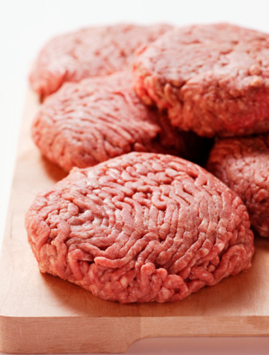Epidemiological studies conducted in France show that beef burger consumption is the main risk factor of a serious disease caused by Shiga toxin-producing Escherichia coli bacteria or STEC.
 A quantitative risk assessment for the consumption of beef burgers containing STEC by the Agence Francaise De Securite Sanitaire Des Aliments concluded that almost 50% of children under the age of 5 eat well-done beef burgers (as well as 29% and 24% of 5-10 year olds and 10-15 year olds respectively). The proportion of beef burgers consumed rare increases with the children’s age: 10%, 17% then 20% for each of the age groups defined (under 5, 5-10 year olds and 10-15 year olds). Regarding the effectiveness of cooking (a frozen beef burger being pan-fried and turned over once), it should be noted that cooking “rare” is associated with a percentage of STEC destruction of 0% to 87% ; “medium” 37% to 96% and “well done” 94% to 99.8%. Concerning the consumption habits that prevail in French households today, these results highlight the importance of the length of cooking on STEC destruction (currently not enough), and the hygiene of beef burger production.
A quantitative risk assessment for the consumption of beef burgers containing STEC by the Agence Francaise De Securite Sanitaire Des Aliments concluded that almost 50% of children under the age of 5 eat well-done beef burgers (as well as 29% and 24% of 5-10 year olds and 10-15 year olds respectively). The proportion of beef burgers consumed rare increases with the children’s age: 10%, 17% then 20% for each of the age groups defined (under 5, 5-10 year olds and 10-15 year olds). Regarding the effectiveness of cooking (a frozen beef burger being pan-fried and turned over once), it should be noted that cooking “rare” is associated with a percentage of STEC destruction of 0% to 87% ; “medium” 37% to 96% and “well done” 94% to 99.8%. Concerning the consumption habits that prevail in French households today, these results highlight the importance of the length of cooking on STEC destruction (currently not enough), and the hygiene of beef burger production.
A place to start might be to accurately define what rare, medium and well-done actually mean, as quantified by time and temperature
Eurosurveillance reports that the Netherlands experienced a nationwide outbreak of Shiga toxin-producing Escherichia coli (STEC) O157 with onset of symptoms from the end of December 2008 until the end of January 2009. A total of 20 laboratory-confirmed cases were linked to the outbreak strain, serotype O157: H-, stx1, stx2, eae and e-hly positive. The investigation into the source of this outbreak is still ongoing, but evidence so far suggests that infection occurred as a result of consuming contaminated raw meat (steak tartare).
